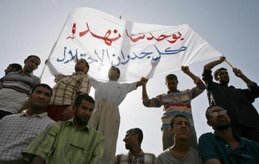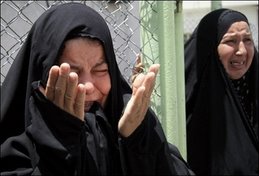U.S. Aims To Lure Insurgents With 'Bait'
Snipers Describe Classified Program
By Josh White and Joshua Partlow
Washington Post Staff Writers
Monday, September 24, 2007; A01A
Pentagon group has encouraged some U.S. military snipers in Iraq to target suspected insurgents by scattering pieces of "bait," such as detonation cords, plastic explosives and ammunition, and then killing Iraqis who pick up the items, according to military court documents.The classified program was described in investigative documents related to recently filed murder charges against three snipers who are accused of planting evidence on Iraqis they killed."Baiting is putting an object out there that we know they will use, with the intention of destroying the enemy," Capt. Matthew P. Didier, the leader of an elite sniper scout platoon attached to the 1st Battalion of the 501st Infantry Regiment, said in a sworn statement. "Basically, we would put an item out there and watch it. If someone found the item, picked it up and attempted to leave with the item, we would engage the individual as I saw this as a sign they would use the item against U.S. Forces."In documents obtained by The Washington Post from family members of the accused soldiers, Didier said members of the U.S. military's Asymmetric Warfare Group visited his unit in January and later passed along ammunition boxes filled with the "drop items" to be used "to disrupt the AIF [Anti-Iraq Forces] attempts at harming Coalition Forces and give us the upper hand in a fight."Eugene Fidell, president of the National Institute of Military Justice, said such a baiting program should be examined "quite meticulously" because it raises troubling possibilities, such as what happens when civilians pick up the items."In a country that is awash in armaments and magazines and implements of war, if every time somebody picked up something that was potentially useful as a weapon, you might as well ask every Iraqi to walk around with a target on his back," Fidell said.Soldiers said that about a dozen platoon members were aware of the program, and that numerous others knew about the "drop items" but did not know their purpose. Two soldiers who had not been officially informed about the program came forward with allegations of wrongdoing after they learned they were going to be punished for falling asleep on a sniper mission, according to the documents.Army officials declined to discuss the classified program, details of which appear in unclassified investigative documents and in transcripts of court testimony. Criminal investigators wrote that they found materials related to the program in a white cardboard box and an ammunition can at the sniper unit's base."We don't discuss specific methods targeting enemy combatants," said Paul Boyce, an Army spokesman. "The accused are charged with murder and wrongfully placing weapons on the remains of Iraqi nationals. There are no classified programs that authorize the murder of local nationals and the use of 'drop weapons' to make killings appear legally justified."It is unclear whether the program reached elsewhere in Iraq and how many people were killed through the baiting tactics.Members of the sniper platoon have said they felt pressure from commanders to kill more insurgents because U.S. units in the area had taken heavy losses. The sniper unit -- dubbed "the painted demons" because of the use of tiger-stripe face paint -- often went on missions into hostile areas to intercept insurgents going to and from hidden weapons caches."It's our job out here to lay people down who are doing bad things," Spec. Joshua L. Michaud testified in Iraq in July, discussing the unit's numerous casualties. "I don't want to call it revenge, but we needed to find a way so that we could get the bad guys the right way and still maintain the right military things to do."Within months of the program's introduction, three snipers in Didier's platoon were charged with murder for allegedly using those items and others to make shootings seem legitimate. Though it does not appear that the three alleged shootings were specifically part of the classified program, defense attorneys argue that the program may have opened the door to the soldiers' actions because it blurred the legal lines of killing in a complex war zone.James D. Culp, a civilian attorney for one of the snipers, Sgt. Evan Vela, said the soldiers became "battle-fatigued pawns in a newfangled concept of 'baiting' warfare that, like an onion, perhaps looked good on the surface, but started stinking to high hell the minute the layers were pulled back and scrutinized."Spec. Jorge Sandoval and Staff Sgt. Michael Hensley are accused by the military of placing a spool of wire into the pocket of an Iraqi man Sandoval had shot on April 27 on Hensley's order. The man had been cutting grass with a rusty sickle when he was shot, according to court documents.The military alleges that the killing of the man carrying the sickle was inappropriate. Hensley and Sandoval have been charged with murder and with planting evidence.As Sandoval and Hensley approached the corpse, according to testimony and court documents, they allegedly placed a spool of wire, often used by insurgents to detonate roadside bombs, into the man's pocket in an attempt to make the case for the kill ironclad.One soldier who came forward with the allegations, Pfc. David C. Petta, told the same court that he believed the classified items were for dropping on people the unit had killed, "to enforce if we killed somebody that we knew was a bad guy but we didn't have the evidence to show for it." Petta had not been officially briefed about the program.Two weeks after that killing, Sandoval and his sniper team stopped for the night in a concealed "hide" in the village of Jurf as Sakhr along the Euphrates River. While other snipers slept, Hensley watched as an Iraqi man, Genei Nesir Khudair, slowly approached the hide. He radioed to Didier, then a first lieutenant, for permission to go for a "close kill.""I told him that as the ground forces commander, I would authorize that if it was necessary," Didier testified. "And about five minutes later, he told me that he had indeed killed the individual."The U.S. military alleges that Vela, on Hensley's order, shot the Iraqi man twice in the head with a 9mm pistol after he had been taken into custody. It was Vela's first kill, and he was visibly shaken. "He looked weird," Sgt. Robert Redfern testified. "Just messed up from it. How would you feel if you had to shoot someone?"At the time the two shots rang out, Sandoval was on guard duty about 20 meters away, out of sight of Vela, inside a broken-down pump house along the Euphrates River, soldiers testified.Vela and Hensley told investigators that the man had an AK-47 with him and that he posed a threat, but other soldiers have alleged that the AK-47 was planted next to Khudair after he was shot.Hensley's attorney could not be reached to comment. Sandoval's attorney, Capt. Craig Drummond, thinks his client is innocent in both deaths."Literally, they have charged this guy with two murders when on both occasions he was just doing his job," Drummond said.Drummond said Sandoval did not have anything to do with placing an AK-47 in the pump-house killing. Sandoval made a statement to investigators discussing his involvement in planting the command wire on the first victim."That was done by one of the soldiers at the scene basically out of stupidity. The guys were trying to ensure that there were no questions at all about this kill," Drummond said. "It was done to overly justify a kill that didn't need justification."Hensley is also charged with killing an Iraqi man whom he approached after the sniper team noticed the man placing wires on a road. Hensley shot him outside his home, maintaining that the man appeared to be moving for a weapon.Two and a half months after the shooting near the pump house, authorities seized Sandoval while he was vacationing at his mother's house in Laredo, Tex. The charges have baffled family members, who describe Sandoval as a caring and honest young man who is being punished for following orders."This has been a shock to all of us," said his eldest sister, Norma Vasquez. "He's been in shock, too, he doesn't know what . . . is going on."Sandoval, a former high school ROTC member, is scheduled to face a court-martial in Baghdad on Wednesday.Vela's father, Curtis Carnahan, said he thinks the military is rushing the cases and is holding the proceedings in a war zone to shield facts from the U.S. public."It's an injustice that is being done to them," Carnahan said. "I feel like you can't prosecute our soldiers for acts of war and threaten them with years and years of confinement when this program, if it comes to the light of day, was clearly coming from higher levels. . . . All those people who said 'go use this stuff' just disappeared, like they never sanctioned it."Partlow reported from Baghdad. Researcher Julie Tate contributed to this report.









